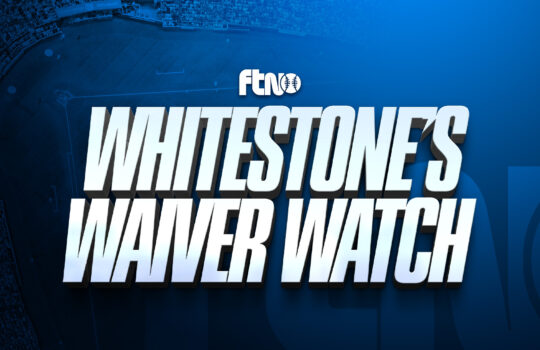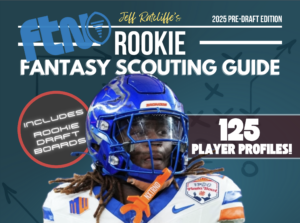
(It’s fantasy baseball draft season! The FTN Fantasy team and a host of helpful guests present our Ultimate 2025 Fantasy Baseball Guide. Check it out and prepare for the 2025 MLB season.)
As fantasy players, we crave data to analyze with which we can construct informed opinions. The purpose here will be to shed light on how to operate when the data we generally analyze — performance at the MLB level — is not a data point yet. We will explore how to weigh what matters — skill sets, minor league performance, organizational depth charts, overall MLB team context — to identify prospects in specific roto categories who can make a fantasy impact this season.
Absent reliable data, it’s vital that we dig deeper into prospects’ skill sets to see how they’ve stacked up against lesser competition and how that can manifest into regular and productive playing time. Two fundamental examples are the skill sets of speed and power.
A rookie with wheels and a combination of a high contact rate and an above-average walk rate can earn playing time and make an impact if the opportunity presents itself. It’s your basic speed with OBP archetype.
Power is often far more hit or miss (if you’ll pardon the pun), because power hitters frequently swing … and miss. For every Kyle Schwarber, there are 20 Joey Gallos who didn’t make enough contact to unlock their otherworldly power. Many of these duds were once highly touted prospects.
Finding fantasy-relevant prospects with no MLB experience is a daunting and often impossible task. We won’t shy away from difficult tasks in these competitive streets, so let’s focus on intentionality for this exercise — segmenting characteristics of prospects with identifiable skill sets and underlying metrics that can directly translate into immediate fantasy production within specific roto categories.
The Archetype
Let’s start with the obvious: No two fantasy prospects are alike. Everywhere we look, we can find top-100 or top-500 prospect rankings lists. Typically, we expect a prospect ranked 13th to be better than one ranked 38th, but that isn’t always the case. Some publications may factor in defensive ability, though fantasy managers only care about defense related to how it affects the prospect’s ability to garner regular playing time. Some may not appropriately value, or account for big league readiness, or a path to playing time created by a hole in the major league lineup. Mostly, we will want to look for players with the following characteristics:
Lorem ipsum dolor sit amet, consectetur adipiscing elit, sed do eiusmod tempor incididunt ut labore et dolore magna aliqua. Ut enim ad minim veniam, quis nostrud exercitation ullamco laboris nisi ut aliquip ex ea commodo consequat. Duis aute irure dolor in reprehenderit in voluptate velit esse cillum dolore eu fugiat nulla pariatur. Excepteur sint occaecat cupidatat non proident, sunt in culpa qui officia deserunt mollit anim id est laborum. "Sed ut perspiciatis unde omnis iste natus error sit voluptatem accusantium doloremque laudantium, totam rem aperiam, eaque ipsa quae ab illo inventore veritatis et quasi architecto beatae vitae dicta sunt explicabo. Nemo enim ipsam voluptatem quia voluptas sit aspernatur aut odit aut fugit, sed quia consequuntur magni dolores eos qui ratione voluptatem sequi nesciunt. Neque porro quisquam est, qui dolorem ipsum quia dolor sit amet, consectetur, adipisci velit, sed quia non numquam eius modi tempora incidunt ut labore et dolore magnam aliquam quaerat voluptatem.
















































 New York Jets
New York Jets  New England Patriots
New England Patriots  Miami Dolphins
Miami Dolphins  Buffalo Bills
Buffalo Bills  Pittsburgh Steelers
Pittsburgh Steelers  Cleveland Browns
Cleveland Browns  Cincinnati Bengals
Cincinnati Bengals  Baltimore Ravens
Baltimore Ravens  Tennessee Titans
Tennessee Titans  Jacksonville Jaguars
Jacksonville Jaguars  Indianapolis Colts
Indianapolis Colts  Houston Texans
Houston Texans  Las Vegas Raiders
Las Vegas Raiders  Los Angeles Chargers
Los Angeles Chargers  Kansas City Chiefs
Kansas City Chiefs  Denver Broncos
Denver Broncos  Washington Commanders
Washington Commanders  Philadelphia Eagles
Philadelphia Eagles  New York Giants
New York Giants  Dallas Cowboys
Dallas Cowboys  Minnesota Vikings
Minnesota Vikings  Green Bay Packers
Green Bay Packers  Detroit Lions
Detroit Lions  Chicago Bears
Chicago Bears  Tampa Bay Buccaneers
Tampa Bay Buccaneers  New Orleans Saints
New Orleans Saints  Carolina Panthers
Carolina Panthers  Atlanta Falcons
Atlanta Falcons  San Francisco 49ers
San Francisco 49ers  Seattle Seahawks
Seattle Seahawks  Los Angeles Rams
Los Angeles Rams  Arizona Cardinals
Arizona Cardinals 










 Boston Celtics
Boston Celtics  Brooklyn Nets
Brooklyn Nets  Philadelphia 76ers
Philadelphia 76ers  New York Knicks
New York Knicks  Toronto Raptors
Toronto Raptors  Chicago Bulls
Chicago Bulls  Detroit Pistons
Detroit Pistons  Milwaukee Bucks
Milwaukee Bucks  Cleveland Cavaliers
Cleveland Cavaliers  Indiana Pacers
Indiana Pacers  Orlando Magic
Orlando Magic  Atlanta Hawks
Atlanta Hawks  Charlotte Hornets
Charlotte Hornets  Miami Heat
Miami Heat  Washington Wizards
Washington Wizards  Denver Nuggets
Denver Nuggets  Minnesota Timberwolves
Minnesota Timberwolves  Oklahoma City Thunder
Oklahoma City Thunder  Portland Trail Blazers
Portland Trail Blazers  Utah Jazz
Utah Jazz  LA Clippers
LA Clippers  Golden State Warriors
Golden State Warriors  Los Angeles Lakers
Los Angeles Lakers  Phoenix Suns
Phoenix Suns  Sacramento Kings
Sacramento Kings  Dallas Mavericks
Dallas Mavericks  Houston Rockets
Houston Rockets  Memphis Grizzlies
Memphis Grizzlies  New Orleans Pelicans
New Orleans Pelicans  San Antonio Spurs
San Antonio Spurs 












